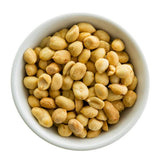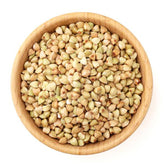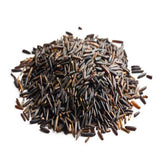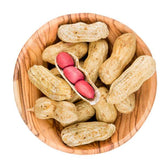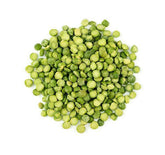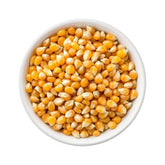Grains & Legumes
We offer a wide variety of certified organic grains and legumes, sourced from Canada when possible. If you are interested in a product that is not listed below, please contact us.
More information about Grains & Legumes
- Grains and legumes are a staple food in many countries around the world and are both incredibly versatile. Grains (particularly whole grains) and legumes boast an impressive nutrient content and provide numerous health benefits.
- Whole grains and legumes are rich in fiber and contain vast amounts of vitamins and minerals. Furthermore, legumes are one of the best sources of plant-based protein. Both these food groups should be part of a healthy balanced diet.
What exactly are grains?
- Grown on grass-like plants called cereals, grains are edible dry seeds that are small and hard. They provide more food energy than any other food group!
- Wheat, corn, and rice are the most common kinds of grains produced and consumed. Other types of grains include barley, oats, sorghum, rye, and millet.
- Buckwheat and quinoa, which are often referred to as pseudocereals, are not technically grains, but they’re prepared and consumed like grains.
Whole grains vs refined grains
- As with other foods, grains also differ in a number of ways.
- A whole grain is made up of three parts. It contains the bran and the germ, which provide fiber and plenty of key nutrients such as proteins, antioxidants, and vitamins and minerals. The third part that a whole grain consists of is called the endosperm, which is the largest part of the grain and contains mostly carbs (in the form of starch) and protein.
- Whole grains can be rolled, crushed, or cracked, but as long as these three parts are in their original proportion, they are viewed as whole grains.
- A refined grain, however, is when the bran and germ is removed and only the endosperm is left.
- Refined grains are generally enriched with nutrients such as B vitamins, folate, and iron to compensate for some of the lost nutrients that occurs during processing.
Our 100% organic grains
- Great accompaniments to a balanced healthy diet are our nutritious organically grown grains such as brown basmati rice, Northern wild rice, quinoa, buckwheat groats, and whole rolled oats.
- The unique and nutty taste, along with its floral aroma makes our organic brown basmati the perfect match for Asian and Indian recipes.
- For a delicious, nutritious porridge or smoothie, why not try our organic rolled oats – which are also a fantastic ingredient for baking!
- Opt for our 100% organic Canadian wild rice for a low-calorie whole grain that contains an impressive amount of nutrients! This nourishing whole grain has a nutty and earthy flavour and perfectly complements soups, stews, and creamy sources! In fact, this nutrient-dense grain is so versatile, it can actually be paired with absolutely any meal you like.
- Then there’s our organically grown quinoa and buckwheat groats. Although these technically aren’t grains, they’re prepared and consumed just like grains. This highly nutritious quinoa makes a perfect side dish and is also a great addition to soups or salads.
- Similarly, buckwheat groats are also packed with nutrients and are extremely tasty too, with just the right amount of crunch.
Now let’s move from grains and find out more about legumes.
What are legumes?
- The legume family comprises specific types of plants that produce a pod that contains seeds — it’s these seeds that are called “legumes”.
- Peas, chickpeas, lentils, beans, and peanuts are common examples of legumes.
- Different types of legumes differ in appearance, taste, nutrition, and even how they are used.
Our organic legumes
- Our organically grown legumes provide plenty of nutrients and numerous health benefits.
- Organic black-eyed beans are a fantastic way to add protein, fiber and texture to a variety of different recipes. Their high protein content makes them a popular ingredient in vegan and vegetarian diets.
- Add a rich flavour and colour to recipes such as stews and casseroles with our organically grown green split peas that contain plenty of fiber, protein, and antioxidants.
- For a legume that’s extremely rich in iron — which can sometimes lack in a vegetarian diet — try our organic brown lentils which are a great alternative to meat. These lentils are also loaded with plant-based protein and nutrients, and are a great addition to soups and dhal.
All of our grains and legumes are 100% organic and both of these versatile food groups play an important role in a healthy balanced diet.
Nutritional Profile
- Whole grains tend to have a higher nutrient content than refined grains. Whole grains are generally rich in many key nutrients such as fibre, B vitamins, magnesium, iron, manganese, iron, and selenium.
- Some grains such as oats and wholewheat are more nutritious than others such as rice and corn.
- When it comes to refined grains, they do tend to be enriched with nutrients such as B vitamins, folate, and iron to compensate for some of the loss of nutrients that takes place during processing.
- The high amount of nutrients found in grains may contribute to their impressive health benefits.
- Legumes too have an incredible nutrient content. They’re rich in fiber and protein, and are packed with plenty of other nutrients such as iron, folate, magnesium, and potassium.
- They also contain the vitamins B1, B3, B5, and B6. Furthermore, other minerals they contain include zinc, manganese, phosphorus, and copper.
Potential Health Benefits
- Research has revealed that consuming whole grains is linked to plenty of health benefits.
- Many studies have shown that eating high amounts of whole grains leads to a lower risk of obesity, heart disease, diabetes and colon cancer.
- Other research has found that those who consume more whole grains tend to live longer than those who consume a lower amount.
- Legumes also offer plenty of health benefits. Legumes are a fantastic source of healthy fibers which feed your beneficial gut bacteria. These health-promoting fibers also help to make butyrate, which are short-chain fatty acids believed to boost colon health and decrease the risk of colon cancer.
- These fibers also help you to feel fuller for longer, and consequently may reduce food intake during the day, potentially promoting weight loss in the long term. Moreover, they’re immensely valuable when it comes to moderating blood sugar levels after meals and are also believed to improve insulin sensitivity.
- Other health benefits that legumes offer include lowering blood pressure, decreasing cholesterol levels and reducing the risk of heart disease.
FAQ
Q: What’s the difference between whole grains and refined grains?
A: A whole grain is made up of three parts: the bran and the germ — which provide fiber and plenty of key nutrients such as proteins, antioxidants and vitamins, and minerals — and the endosperm. The endosperm is the largest part of the grain and contains mostly carbs and protein.
A refined grain is when the bran and germ is removed and only the endosperm is left.
Refined grains are generally enriched with nutrients such as B vitamins, folate, and iron to compensate for some of the lost nutrients that take place as a result of the processing.
Q: What are pseudocereals?
A: Pseudocereals are not technically grains but they’re prepared and consumed like grains. Examples include buckwheat grouts and quinoa.
Q: Why are legumes popular in vegetarian diets?
A: Legumes have a high protein content which makes them great for vegan and vegetarian diets. A legume such as brown lentils are very rich in iron making them a perfect substitute for meat.


